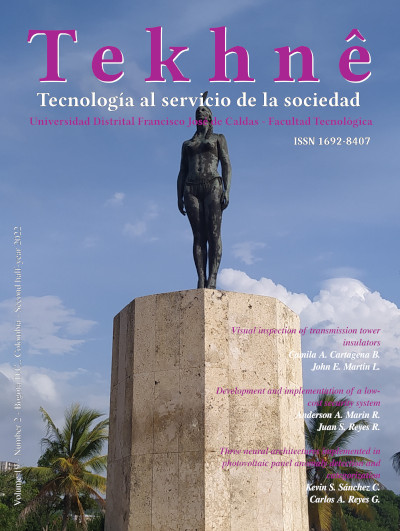Published:
2022-12-30Issue:
Vol. 19 No. 2 (2022): Tekhnê JournalSection:
ArticlesVisual inspection of transmission tower insulators
Inspección visual de aisladores para torres de transmisión
Keywords:
Artificial intelligence, drone, electricity, isolators, transmission tower (en).Keywords:
Aisladores, dron, electricidad, inteligencia artificial, torre de transmisión (es).Downloads
Abstract (en)
One of the most important processes in the maintenance of electrical networks is the detection of faults in the insulators of transmission towers. These prevent an unexpected voltage drop at a point on the line. Therefore, it is necessary to maintain and supervise them in time so that they do not act inefficiently. There are systems to facilitate, streamline, and classify the detection of faults without putting anyone at risk, since the maintenance of electrical systems is one of the most risky and thus requires a quick solution. In this article, a methodology was implemented that facilitates the location of faults in the insulator system by means of an image that is captured by a drone and sent to the database to be analyzed by the code, detecting the possible fault.
Abstract (es)
Uno de los procesos más importantes en el mantenimiento de redes eléctricas es la detección de fallas en los aisladores de las torres de transmisión. Estos evitan que exista una caída de tensión no esperada en un punto de la línea. Por ello, es necesario el mantenimiento y supervisión a tiempo para que no actúe de manera ineficiente. Existen sistemas para facilitar, agilizar y clasificar la detección de fallas sin poner en riesgo ninguna persona, ya que el mantenimiento de los sistemas eléctricos son uno de los más riesgosos y así buscando una rápida solución. En este artículo se implementó una metodología que facilita la ubicación de fallas en el sistema de aisladores por medio de una imagen que es capturada por un dron, enviada a la base de datos para ser analizada por el código, detectando la posible falla.
References
Belitsyn, I. V., Pestov, M. I., Pavlichenko, I. A., & Belitsyn, A. I. (2021). Fault simulation in networks with isolated neutral to find the fault location in power transmission lines. Journal of Physics: Conference Series, 2131(3), 032045. https://doi.org/10.1088/1742-6596/2131/3/032045
Cadena, A., Peña, E., & Martínez, F. (2016). Desarrollo de prototipo de quadrotor con sistema de comunicación inalámbrica bidireccional. Tekhnê, 13(1), 13–30.
Gao, Q., liu, S., Yang, Y., & Zhang, C. (2019). Study on the influence of insulator on the coupling effect of transmission tower-line system. Journal of Physics: Conference Series, 1187(2), 022030. https://doi.org/10.1088/1742-6596/1187/2/022030
Guo, L., Liao, Y., Yao, H., Chen, J., & Wang, M. (2018). An electrical insulator defects detection method combined human receptive field model. Journal of Control Science and Engineering, 2018(1), 1–9. https://doi.org/10.1155/2018/2371825
Khanna, J. (2021). Performance evaluation of two basic controls over the boost powerregulator: Pid and fuzzy controllers. Tekhnê, 18(1), 37–49.
López, R., Batista, M., & Jimenez, M. (2021). Autonomous uav system for cleaning insulators in power line inspection and maintenance. Vol. 21(8488), 10–50. https://doi.org/10.3390/s21248488
Martínez, F., Martínez, F., & Montiel, H. (2020). Low cost, high performance fuel cell energy conditioning system controlled by neural network. TELKOMNIKA (Telecommunication Computing Electronics and Control), 18(6), 3116–3122.
Martíez, F., Martínez, F., & Jacinto, E. (2017). Visual identification and similarity measures used for on-line motion planning of autonomous robots in unknown environments. In Y. Wang, T. D. Pham, V. Vozenilek, D. Zhang, & Y. Xie (Eds.), Eighth international conference on graphic and image processing (ICGIP 2016). SPIE. https://doi.org/10.1117/12.2266997
Mohana, K., Hussain, A., Kavya, B., J., B., & Kaliappan. (2021). Deep learning for fault diagnostics in bearings, insulators, pv panels, power lines, and electric vehicle applications—the state-of-the-art approaches. IEEE, Vol.9(20657183), 41246–41260. https://doi.org/10.1109/ACCESS.2021.3064360
Montiel, H., Jacinto, E., & Martínez, F. (2021). A double-loop hybrid approach for the recognition of fissures in bone structures. ARPN Journal of Engineering and Applied Sciences, 16(11), 1151–1156.
Ochoa, Y., & Penagos, C. (2021). Traveling wave method for analysis of faults in a high voltagetransmission line. Tekhnê, 18(2), 13–18.
Odo, A., McKenna, S., Flynn, D., & Vorstius, J. B. (2021). Aerial image analysis using deep learning for electrical overhead line network asset management. IEEE Access, 9(2021), 146281–146295. https://doi.org/10.1109/access.2021.3123158
Rodríguez, A., & Buitrago, X. (2022). How to choose an activation function for deep learning. Tekhnê, 19(1), 23–32.
Romero, D., Sánchez, B., & Garzón, N. (2019). Conserving water is conserving your life. Tekhnê, 16(1), 23–34.
Sampedro, C., Rodriguez-Vazquez, J., Rodriguez-Ramos, A., Carrio, A., & Campoy, P. (2019). Deep learning-based system for automatic recognition and diagnosis of electrical insulator strings. IEEE, Vol. 7(18880601), 101283–101308. https://doi.org/10.1109/ACCESS.2019.2931144
Sopelsa, N., Frizzo, S., & Meyer, L. (2021). A study of multilayer perceptron networks applied to classification of ceramic insulators using ultrasound. Vol. 11(1592), 50–150. https://doi.org/10.3390/app11041592
Yin, F., Liu, P., Mei, H., Wang, L., Li, L., & Farzaneh, M. (2020). The shed hole influence on the electrical performance of composite insulator. IEEE, Vol. 8(20184521), 217447–217455. https://doi.org/10.1109/ACCESS.2020.3042245
How to Cite
APA
ACM
ACS
ABNT
Chicago
Harvard
IEEE
MLA
Turabian
Vancouver
Download Citation
Visitas
Downloads
License
Copyright (c) 2023 Camila A. Cartagena B., John E. Martín L.

This work is licensed under a Creative Commons Attribution-NonCommercial-NoDerivatives 4.0 International License.
Those authors who have published with this journal agree to the following terms:
- The authors retain their copyright and guarantee to the journal right of first publication of his work, which will be simultaneously subject to license recognition of Creative Commons that allows others to share the work as long as its author is indicated and its first publication in this journal.
- Authors may adopt other agreements nonexclusive distribution version of the work as long as indicated that the initial publication is in this journal.
- It allows and encourages authors disseminate their work via the Internet before and during the submission process, which can produce interesting exchanges and increase citations of the published work.


